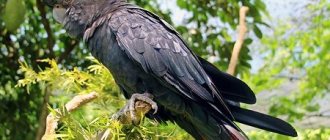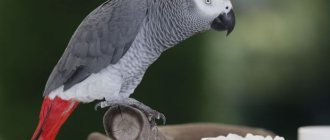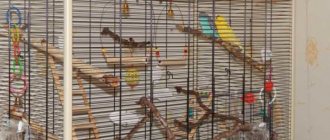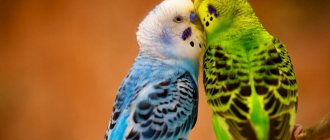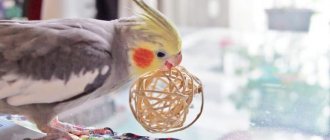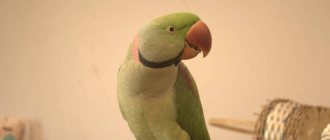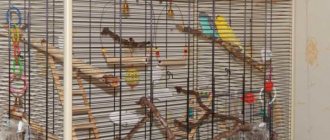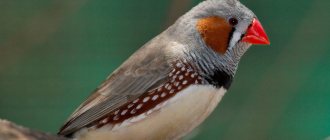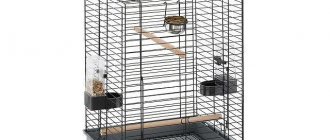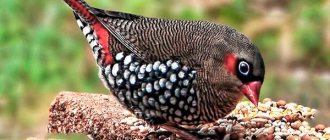Ringed parrots are cheerful and smart birds. This species is distributed in eastern Africa and southern Asia. In their homeland, the birds live mainly in forests and nest in hollows.
These birds were valued back in Ancient Rome. They were kept in ivory cages, and specially trained people looked after the birds.
Nowadays, necklace parakeets are no less popular among poultry breeders. It is not difficult for them to create good conditions even in a city apartment. However, some features of breeding and keeping these birds still need to be taken into account before purchasing them.
Bird character
The bird is characterized by great mobility, noisy and loud behavior. In nature, they actively search for food until noon, then fly in flocks in search of life-giving moisture. At lunchtime they relax in the shade of tropical trees. They flutter swiftly and quickly, often flapping their wings. It walks along the ground slowly, like a bear, waddling from foot to foot.
Character of the necklace parrot
A feature of the Indian ringed is their good nature and cheerful disposition. Among people he adapts quite quickly. The bird is intellectually developed. Has the ability to imitate human speech and reproduce the sounds of other animals. They remember melodies well. Although it should be noted that this talent is not as developed as in other species of parrots.
Read also
How to determine the sex of a necklace parrot
Description of the species
There are 13 varieties of ringed parrots, each of which has its own distinctive characteristics: for example, a pink breast in the rose-breasted parrot, a red head in the plum-headed parrot, and a stripe on the bridge of the nose in the Kramer parrot. What everyone has in common is a necklace around their neck. At the front there is a black “collar” that closes at the back of the head in the form of a necklace of a contrasting color - pink, blue or light green. Females and young males do not have this stripe.
The bird has a slender, fit body of medium size: size 40 - 45 cm, half of which is a thin, pointed tail. The wings, back and belly are covered with green feathers of different shades with clear transitions. The feathers fit tightly to each other and do not puff up anywhere, resulting in a very neat, neat appearance.
Another feature of the necklace parrot is its rounded beak, wide at the base and sharp at the tip. The mandible is colored red or orange, the mandible is brown, it is significantly smaller than the upper part. The tail is cascading, the longest feathers grow in the center, their shade is turquoise.
Important: the natural color of necklace parrots is grassy green. During breeding, individuals with white, blue and yellow plumage were bred for domestic keeping.
How does age affect taming ability?
The result of successful domestication of a Kramer parrot largely depends on the age of the acquired pet. If he is more than two years old, then, despite all the efforts of the owner, he may not perceive educational moments at all.
It is best to purchase birds under 5 months of age and, preferably, from professional breeders. In pet stores, birds live in a cage or enclosure with their own kind and get used to their flock instincts. In such cases, it will be difficult for her to adjust to life surrounded by people.
Taming an adult Indian ringtail can take many years, while young animals begin to respond to the first training within 2-3 weeks.
The influence of a parrot's age on its domestication
I recommend starting classes immediately after adaptation to an unusual environment, the main thing is love, affection and perseverance.
Breeding offspring in captivity
At 3 years old, ringed birds are ready to mate. This should not be done before, as the birds will produce weak and non-viable offspring. Breeding necklace parrots at home is quite feasible.
To do this you need to get a couple of birds. They will live together all their lives. The girl gets used to her partner, and he takes care of her and the offspring. Reproduction begins in November. To breed offspring, a special nest box is equipped. This house measures 35 cm in height, 25 cm in width and 30 cm in length. It is made of plywood or boards. The bottom is covered with sawdust. The new house will interest the pets, and the necklace parrots will begin to breed within 5-15 days. After 2 weeks, egg laying will begin. The female will incubate them for 24 days.
At 3 weeks of age, necklace parrot chicks need additional feeding. They do this with the help of special feed. At 2.5 months, the birds will begin to feed on their own. At about six months, the offspring can be kept separately.
Even an amateur can cope with breeding Ozherelov parrots at home if he creates all the necessary conditions for this.
The Ringed is a simple and unpretentious bird with a complex character. If you find an approach to it, then keeping parrots at home, including necklace parrots, will not cause trouble to their owner.
Compliance with the rules of nutrition, hygiene, and upbringing is important for the normal functioning of the bird. The domestic ringed parrot fully justifies its care and maintenance with its cheerful chatter and intelligence.
Step-by-step instructions for taming
So, you have purchased a new pet, and you are taking it home. Know! For any living creature, a change of environment is a great stress. First of all, the chick needs to get used to the new place and the presence of a person in its life.
How to establish a trusting relationship with an Indian ringtail, so that later you can easily start teaching good behavior?
My tips:
- As soon as the parrot is in the home, put it in a cage. He must get used to the new environment. Do not disturb the bird unless necessary. Just watch from the side.
- If Kramer's parrot has stopped rushing around his new home, is not nervous, does not scream and does not beat his wings, it means that he has adapted and accepted the living conditions.
Instructions for taming a necklace parrot
Acquaintance
Taming should begin with introduction. Food, water and toys are placed in the cage. The pet must realize that it is safe.
In order for the necklace parrot to get used to the owner’s voice, you can call him by name quietly and in a sing-song voice. Yes! Give him a nickname right away!
The contact is considered successful when, when the breeder approaches, the bird does not hide, does not rush about, and boldly eats food and drinks water.
Rapprochement
Indian ringed parakeets are highly sensitive to the intonation of human speech.
It is important to talk to her as often as possible. The voice should be gentle and friendly. During communication, you are allowed to bring your hand to the pet’s cage and hold it motionless. Then the bird will no longer be afraid of the presence of hands near its shelter.
Getting close to a parrot
If the bird reacts normally to all the manipulations performed and does not show excessive anxiety, you are allowed to slowly open the doors of the house and stick your palm in, preferably with a tasty treat.
Hand in a cage
If the bird starts to rush around and tries to hide, the hand in the cage should remain motionless. While the parrot is afraid of minimal rustles, it is better not to take further steps.
A treat (preferably a bright color - because parrots react to this) in the palm of your hand can be a good bait in gaining trust. The bird will become interested and want to sit on your hand.
Care
This bird is unpretentious and does not require anything fancy to keep. But the necklace parrot needs some special “conveniences” at home.
Housing
Ringed parrots are freedom-loving birds; they need a lot of space to live. The cage for a necklace parrot should be spacious. For one individual, a dwelling measuring 1 x 2 m is allocated. For a couple of such birds, it is better to make a spacious aviary. The rods are placed horizontally so that the pet can climb on them. It is better to prefer steel, since the necklaces love to misbehave and peck at the cage, trying to escape from captivity.
The bird house is equipped with all the necessary equipment:
- feeder;
- drinking bowl;
- bathhouse;
- toys so as not to get bored in the absence of the owner;
- twigs, perches, ropes.
On a note. The bird must be occupied alone, otherwise it will develop health problems.
An aviary or cage for a necklace parrot should be equipped with many entertaining accessories for games. Then he won’t start pecking at the twigs and wasting away from boredom.
Nutrition
At home, the necklace parrot feeds like other species of birds. The main food is a grain mixture. There is a large selection of it in pet stores. You can prepare the composition yourself, knowing the ratio of ingredients. Poultry mixtures consist of grains in the following quantities:
- millet (40%);
- oats and wheat – 20% each;
- canary, flax and sunflower seeds - 10% each.
Ready-made commercial food should be taken for medium-sized birds. The diet in them is designed for necklace parrots, which are kept and cared for in captivity.
On a note. The diet of poultry can be varied with fruits, vegetables, herbs, cereals, cottage cheese, and hard-boiled eggs.
Hygiene
Even beginners do not have any problems with how to care for a necklace parrot. The main thing is to regularly clean the bird’s home, monitor its diet and regularly change the water in the drinking bowl and bathing bowl. Poultry dishes must be washed daily.
We invite you to sit on your hand
When the chick no longer runs away with the food he has obtained to the far corner of his home, the treat is placed so that he can sit comfortably on the palm of his hand, trying to get the food. In such cases, do not make sudden movements so as not to scare the parrot.
Teaching a parrot to sit on your hand
The ideal result of these manipulations is that the Ozherelovy runs as fast as he can towards the treat and, having positioned himself more comfortably, eats from his hand. Now you can safely move on to the next stage.
Diseases and treatment
The first signs of the disease
A healthy parrot leads a very active lifestyle, it is cheerful and cheerful, it is interested in the people and surroundings, and when resting it rests on one leg. When a pet starts to get sick, it immediately affects its behavior: it sleeps a lot, while standing on two legs, stops grooming its plumage, begins to tremble, and may sit with its eyes closed.
All these symptoms are alarming and indicate the presence of a disease in your pet.
Common diseases
Diseases of pet parrots are divided into two types: viral and bacterial.
Viral ones include:
- Bird flu is a dangerous disease characterized by a high mortality rate. Its symptoms are: decreased appetite, loss of interest in others, loss or breaking of feathers, lethargy. In order to avoid consequences, the bird must be isolated in time from already infected birds;
- smallpox virus is an incurable disease characterized by the following symptoms: first, the bird becomes lethargic, its appetite decreases, a white coating forms on the tongue, then abscesses appear on the head, vomiting and diarrhea mixed with blood occur. Thus, the body becomes dehydrated, the parrot begins to have convulsions, and then paralysis occurs.
Bacterial diseases include diseases that are described below:
- aspergillotoxicosis - the cause of this disease is the Aspergillus fungus, which reaches the pet through food. This disease comes in two forms: chronic and acute. The latter form is characterized by seizures, so immediately after detecting the first symptoms you must contact a veterinary clinic;
- inflammation of the goiter - the cause of this disease is poor-quality food or contaminated water. Its symptoms are: enlarged goiter, the appearance of mucus, diarrhea, vomiting with pale gray mucus;
- inflammation of the eyes and lacrimal glands – conjunctivitis is caused by a variety of bacteria. Symptoms of this disease: the very first - the parrot always tries to scratch its eye on some objects, then the eye turns red and swollen, the eyelids may stick together, and the pet itself becomes restless.
Any disease of a feathered pet deserves special attention from the owner. Therefore, at the first suspicion that something is wrong with the bird, you need to contact a veterinarian.
How to stimulate your pet
As I said above - of course, tasty and colorful pieces of food. It could also be toys. Kramer's parrot really likes to admire himself. Buy a special mirror made of polished metal. He will communicate with him.
However, remember! All steps towards taming are done gradually and very carefully. Don't be too intrusive.
Stimulating the parrot to take action
How long does it take to tame a necklace parrot?
Having bought a chick several years ago and decided to finally tame it, you will do this for a year, a month, an hour, but everything will be in vain, because the most important criterion in raising your pet is age. It is wrong to say that if a bird is an adult, then it is easier to tame and train it, because it is now much more intelligent.
On the contrary, it is best to engage in taming as early as possible, because once a parrot reaches more than three years of age, its behavior can no longer be changed.
There is even a danger that he will begin to experience panic at the sight of you, not understanding the meaning of your actions and seeing them as a threat. Therefore, it is best to buy a pet that is no more than six months old and immediately start training it so as not to miss this opportunity.
Did you know? Parrots have a great sense of rhythm.
If you turn on the music, the parrot will begin to move to it, as if dancing.
Toys
Toys are a great incentive to get closer to a person. An important role here is played by such a distinctive character trait as curiosity. Bells, beads, rattles, rings should be bright and safe.
Necklace parrots how to teach parrots to hand
To teach the chick to leave their home, you can place them right next to the door or hang them on your hand.
Full communication
At some stage in the development of your relationship with the parrot, he will stop being afraid of you, will be happy to fly out of the cage, sit on you, take food from your hands, etc. This is the time for real creativity and enjoyment from full communication with your necklace parrot. Here are some tips for organizing joint leisure, although they only slightly outline the variety of possible options:
- Teaching the necklace parrot human language. A most interesting process, the result of which will be not only a cheerful “hello” that greets you when entering the room, but also more complex words and phrases. Very often it may seem to you (or not seem?) that your parrot has a much higher intellectual level than you might have thought at the very beginning, when you just got him. But you have to start with simple words. For example, say “hello” every time you enter a room. Teach your pet other words in the same way. As you already understand, the main thing is regularity of training. They won’t take much time; you can do it casually, by chance.
- Dancing is an integral part of the life of every self-respecting parrot. Observe what kind of music he likes best, usually songs performed by high-pitched voices or instruments. And if you have a voice that is not too deep, congratulations, you are in luck: your pet will learn to speak faster and more successfully than if you were to speak in a deep voice. As for dancing, parrots usually start dancing to their favorite music without any stimulation. If your Pop has not yet figured out how to diversify his life with this, then help him by making nodding movements with his head or rotating movements with his body, or something else. Whatever your imagination tells you. Parrots respect all kinds of creativity, and, if desired, they will repeat what you do. They're parrots.
- If you are not one of the lazy owners who are reluctant to exercise with their pets, you can try teaching your necklace parakeet how to balance on a ball. Select a small ball, place a bird on it and lure it. Experienced parrot experts say that learning this trick happens quite quickly.
- Another trick you can teach your parrot will be a lot of fun. All you have to do is notice any striking feature inherent in your pet, and emphasize it using a gesture and voice command. So, one day your tamed parrot will be able to amuse the guests by falling with its paws up when you shout: “All clear!”
It must be said that the process of taming a necklace parrot, as well as other species, will be faster and more effective if you are dealing with a young bird. Further, the older your bird gets, the more difficult it will be for you to win her over. In some cases, taming an adult bird is almost impossible. The parrot will only get used to you a little, that's all you can count on. Don’t despair - most likely, your care, love and patience will work a small miracle, and your bird will reward you a hundredfold for all your work.
How to train a parrot to fly to you
After the parrot begins to sit on the palm without fear, you need to try to teach it to fly out of the cage directly to the person. To do this, the distance between bird housing and humans is increased daily. This eliminates the possibility of simply jumping from the bar onto your hand and taking a treat or playing with a toy.
At first, the bird may simply grab food and immediately fly back, but over time it will begin to understand that nothing threatens it and will cheerfully flutter around the room, sitting on objects and the owner’s shoulder.
Lesson 5: Leaving the Cage
Continuing the reinforcement of the previous lesson, practice landing on your hand for several days. Remember to speak to your parrot in a calm and even voice. At this time there should be no extraneous noise - screams, knocks, claps. Any sharp sound can alert the bird and disrupt the lesson. During classes, it is better for the pet to be alone in the cage. The company will only get in the way.
Now it's time to leave the cage on the owner's hand. To do this, you must slowly and carefully move your hand with the parrot towards the door, calling the pet by name and enticing it with a treat. Repeat these steps until you achieve success. To reinforce the results, give him a treat. Then make the challenge more difficult by moving around the room.
